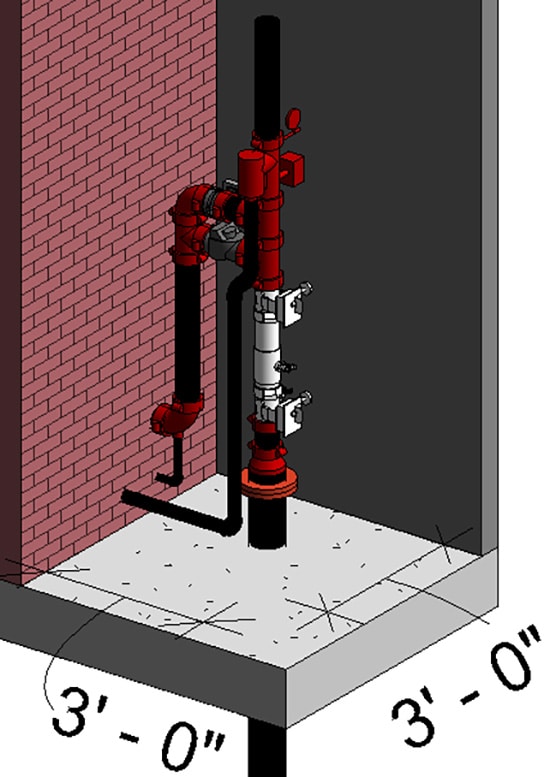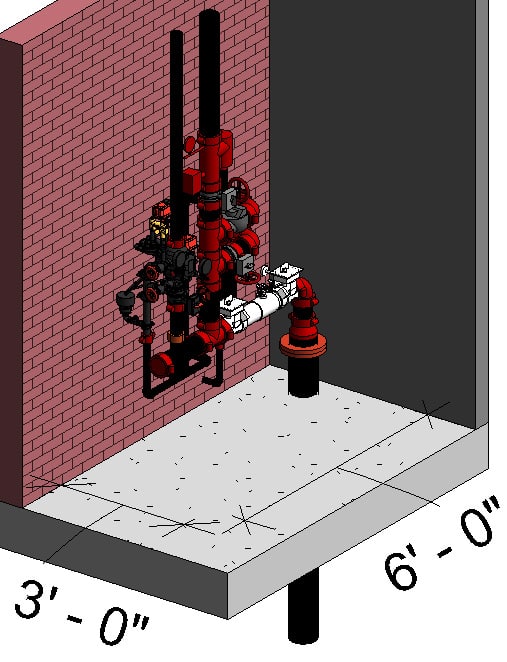
We live in a world where project budgets are based on cost per square foot. The efficient use of floor space matters in order to minimize costs for owners and maximize occupancy use for end-users.
One factor in this equation is the design and incorporation of fire riser rooms in commercial spaces. When it comes to maximizing the floorplan of a commercial facility, teams can find themselves at a standstill as owners, general contractors, consultants, and fire marshals may have a variety of questions on the correct approach.
In order to help your project team avoid situations that can hold up design (and potentially cost time and money), the International Building Code (IBC) can help answer some of the questions regarding fire riser rooms.
Every jurisdiction is different, and therefore all of them have different requirements. Some fire marshals do require a door to the outside of the building. Other fire marshals even require the fire riser rooms to be locked. This is one of the many reasons to involve the fire marshal and a professional Fire Protection Designer in the design and layout early in the project.
We understand why there are so many questions on fire risers. Take for example, the IBC’s statement regarding sizing a fire riser room:
Pump and riser room size – Where provided, fire pump rooms and automatic sprinkler system riser rooms shall be designed with adequate space for all equipment necessary for the installation, as defined by the manufacturer, with sufficient working room around the stationary equipment. Clearances around equipment to elements of permanent construction, including other installed equipment and appliances, shall be sufficient to allow inspection, service, repair or replacement without removing such elements of permanent construction or disabling the function of a required fire-resistance-rated assembly. Fire pump and automatic sprinkler system riser rooms shall be provided with doors and unobstructed passageways large enough to allow the removal of the largest piece of equipment. (IBC 2018, 902.1)
The space required to house fire riser rooms must be designed with “adequate space” and offer a “sufficient” working room to inspect, service, repair, and replace equipment. In other words, it needs to be big enough. As you might have guessed, this statement creates more questions than answers. While working with owners, contractors, consultants, and others, we have often faced this question.
To get right down to it, the size of your project’s fire riser room depends. Each project is different, and fire protection needs must be adjusted accordingly.
While there may never be any definitive statement on how large a fire riser room needs to be, we can share a few best practices when considering fire riser design.

Image 1: A typical layout for a fire riser in a building less than 52,000 sq. ft. that is heated throughout.

Image 2: A typical layout for a fire riser in a building less than 52,000 sq. ft. with an area not heated and requiring the fire sprinkler system piping to contain air.
1. The fire riser is not required to be located/installed inside its own dedicated room.
As long as there isn’t a fire pump involved, the IBC allows other building equipment to be located in the same room as a fire riser. You may be able to place the riser in the same room with other equipment you are trying to conceal. Boilers, pumps, backflows, and even storage can be located in the same room as long as the area around and in front of the riser remain clear and accessible. Co-locating fire riser equipment with other building equipment can maximize a building’s floor space.
2. The fire riser room is not required to be locked.
People often assume the fire riser room should be locked to prevent tampering with valves and equipment. However, not only is this not required, but if you decide to lock the room, the code requires you always to keep a key available. The IBC states:
Access – Automatic sprinkler system riser, fire pump, and controllers shall be provided with ready access. Where located in a fire pump room or automatic sprinkler system riser room, the door shall be permitted to be locked, provided that the key is available at all times. (IBC 2018 902.1.1)
3. The fire riser is not required to be in any back of-house room.
If we do not need to put it in its dedicated room, which doesn’t have to be locked, then why not place the fire riser right out in the open? Place the riser right at your entrance for everyone walking into that building to see and admire (OK, maybe you don’t want the fire riser to be the focal point at the entrance of the art gallery you are designing). But if you are constructing a warehouse or factory, consider having the fire riser on the main floor. This approach, again, can be a space saver.
4. You do not need a door in the fire riser room that opens directly to the outside.
You only need a door that opens directly to the outside if you have a fire pump in that room. NFPA states:
Except as provided in 4.13.2.1.1.1, fire pump rooms not directly accessible from the outside shall be accessible through an enclosed passageway from an enclosed stairway or exterior exit.
5. Nine square feet per system valve is typically enough space for your fire riser room.
Every project is unique, true, but is there any rule of thumb on space needs? In my experience, at a minimum, leave at least 9 ft2 space per fire riser system valve while maintaining at least 3 ft of space in front of the fire riser that will always remain open and free from storage.
What does this mean? Let’s say you are constructing a building that’s less than 52,000 ft² and is heated throughout. This would require one system valve. So provide yourself 9 ft² for the fire riser and at least 3 ft of space in front of that valve. Or 18 ft² total. (See Image 1 above).
Maybe your building is constructed of wood and has an attic that requires fire sprinkler protection. Combustible spaces require fire sprinkler protection, and now the riser will have an additional dry valve to protect this unheated combustible space. You just added another system valve on your riser and need another 9 sq. ft. for room that your equipment takes up. Now your equipment is taking up 18 sq. ft. and you need to provide 3 ft of space in front of that equipment.
One solution is to consider placing this riser in a 3 ft x 6 ft closet with double doors that opens into a hallway. The closet provides room for the riser, and once the doors are open, your hallway provides 3 ft of space in front of the riser. (See Image 2 above).
Now let’s say your building exceeds 52,000 sq. ft., is four stories high, and has an outside overhang that requires compressed air in the fire sprinkler riser. As projects get more complicated, it might be time to stop trying to figure this out yourself and consider getting a professional fire protection designer involved in your project. (See Image 3 below).
6. Get the fire marshal involved.
Every jurisdiction is different, and therefore all of them have different requirements. Some fire marshals do require a door to the outside of the building. Other fire marshals even require the fire riser rooms to be locked. This is one of the many reasons to involve the fire marshal and a professional Fire Protection Designer in the design and layout early in the project. If we can address questions and concerns early, we can avoid hanging up the design toward the end of the project and making costly adjustments later.